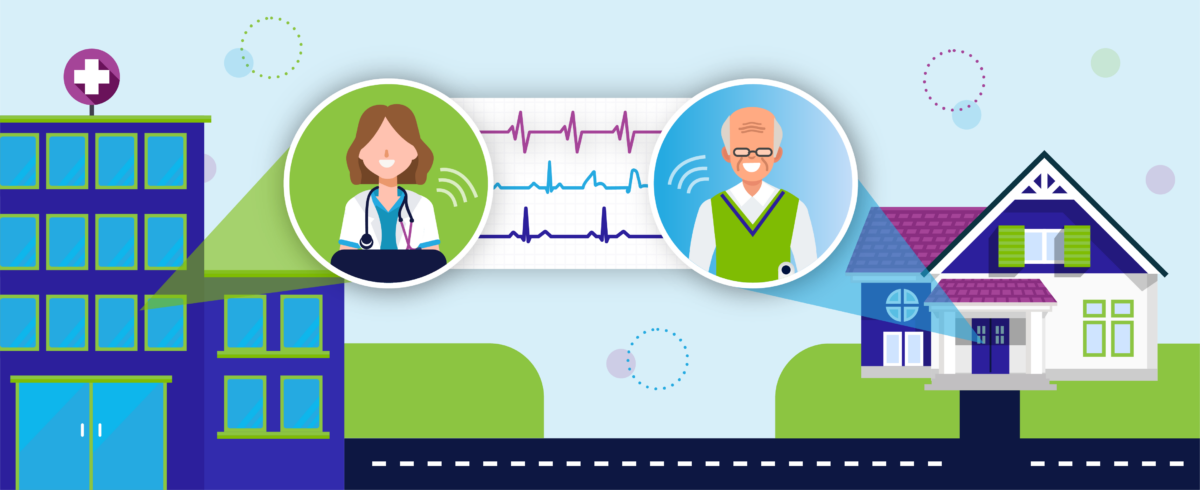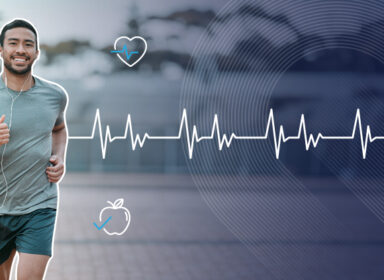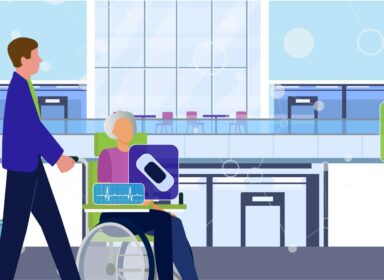Virtual telemetry has become a healthcare hot topic because of its integral role in enabling the full potential of virtual care and remote patient monitoring (RPM) for both patients and providers.
This is especially true when it comes to cardiology. Many cardiovascular providers have begun integrating RPM or virtual telemetry solutions into their everyday practice. And statistics show it will become even more prevalent in the near future—the global cardiac telemetry market is expected to continue its exponential rise, growing from USD $900 million last year to $2300 million by 2030, at a CAGR of 12.1%.
It’s important to integrate technology into cardiac care when it makes sense, as it has great potential to improve patient outcomes; however, it can be difficult to determine which virtual telemetry device is right for you and your patients. In this blog post, we will take a look at virtual telemetry as a whole, answer some pressing questions about it, and detail its ins and outs for healthcare professionals looking to integrate such technology into their care practices.
What is virtual telemetry?
To start, it’s important to understand what virtual telemetry is exactly. At its core, virtual telemetry is the use of sensors or other devices to collect, transmit, and measure patient cardiac data. Virtual telemetry leverages digital platforms and networks to transmit and receive this information, eliminating the need for physical connections between the patient and traditional in-office or in-hospital monitoring equipment.
While its utility is broad, virtual telemetry is particularly exciting in the cardiovascular space, where high-fidelity patient monitoring has the potential to transform operating models, care quality, and patient outcomes.
Where does it fit in cardiology?
Telemetry platforms are frequently introduced in the cardiologist’s office for both in-office diagnostics and at-home monitoring. In the office, physicians can record baseline measurements while introducing the patient to the remote monitoring process. This ensures that after the appointment, patients are able to utilize the technology without clinical intervention. They can then be monitored from afar, as their provider interprets cardiac data remotely. Through virtual telemetry and RPM, cardiologists can analyze non-event data to improve understanding and the precision of diagnoses. But the value of cardiac telemetry extends beyond diagnostics, too.
Post-diagnosis, virtual telemetry allows providers to remotely monitor patients leading up to surgery and make sure they can be safely cleared for the operation. After surgery is completed, virtual telemetry can be used to monitor patients post-discharge and ensure they are progressing in their recovery. As virtual telemetry continues to develop, the goal is to enable a virtual extension of the hospital where patients can receive hospital-grade monitoring at home. This ‘Virtual Care Unit’ may help alleviate hospital crowding and clinical burden while delivering exceptional care and convenience to patients no matter their location.
While this technology is valuable, there are different methods for how devices collect and report data, and understanding those differences is essential to understanding which virtual telemetry platform fits your needs.
What is the difference between contiguous vs. continuous monitoring?
In the context of virtual telemetry, there are two different approaches in collecting and transmitting data from medical devices: contiguous monitoring and continuous monitoring. Contiguous monitoring typically implies that data is captured and transmitted in discrete segments or intervals.
For example, a monitoring system might record and transmit data whenever there is an event that meets the criteria to be communicated, creating distinct blocks of information. This method can be advantageous in terms of data management and bandwidth usage, as it allows for a more controlled flow of information and might be suitable for scenarios where real-time updates are not critical, or where there are constraints on resources. However, the drawback with contiguous monitoring is that there are inherent gaps in data between the monitoring intervals, which could potentially result in missing brief but significant changes in patient condition.
On the other hand, continuous monitoring implies a seamless and uninterrupted flow of data in near real-time. This approach involves capturing and transmitting data constantly, without predefined intervals. Continuous monitoring is particularly valuable in situations where immediate awareness of changes in a patient’s status is crucial. The challenge with continuous monitoring, however, lies in the potential for increased data volume and the need for robust data transmission capabilities. This method demands a higher level of resources to handle the constant stream of information, or more technologically advanced data systems, like AI-enabled reporting.
Why does this difference matter?
The distinction between contiguous and continuous monitoring is particularly significant for cardiologists due to the dynamic and time-sensitive nature of cardiac conditions. Cardiologists rely on accurate and timely data to assess a patient’s cardiovascular health and make informed decisions, meaning that more often, they benefit from a continuous data stream. The following are key benefits of continuous monitoring:
- Holistic Patient Assessment: To make the best decisions for their patients, cardiologists need a comprehensive view of a patient’s cardiac activity to assess overall heart health accurately. Continuous monitoring provides a more holistic understanding, enabling the detection of patterns, trends, and subtle changes in the patient’s condition.
- Comprehensive Trend Analysis: Continuous monitoring facilitates in-depth, comprehensive trend analysis as cardiologists can study long-term patterns and correlations in a patient’s cardiac data, contributing to a better understanding of the progression of cardiovascular diseases and the effectiveness of different treatment methods.
- Detection of Events: Cardiac events, such as arrhythmias or ischemic episodes, can be transient and may occur sporadically. Continuous monitoring ensures that these brief but critical events are captured in near real-time, allowing cardiologists to identify patterns that they might otherwise miss and take action.
- Individualized Treatment Plans: Different patients have different cardiovascular conditions and challenges, which means they also all have different responses to treatment. Continuous monitoring allows cardiologists to tailor treatment plans based on near real-time data, adjusting medications or long-term plans more accurately and as needed based on continuing developments.
InfoBionic Brings Virtual Cardiac Telemetry to the Forefront of What’s Next
Virtual telemetry has unleashed new possibilities in cardiac care and beyond. As a leader in virtual cardiac telemetry and remote monitoring solutions, InfoBionic continues to push the boundaries of what’s possible.
InfoBionic’s MoMe® ARC—which has received FDA 510(k) Clearance—delivers high-fidelity insights to care providers without interruption. Our mission is to turn native cardiac data into clinical insight, with a virtual telemetry platform that combines AI-enabled analysis and continuous remote ECG that’s tailored to each person—elevating cardiac care to new heights with real benefits for patient and provider alike.
Contact us to learn more about the MoMe® ARC today.


